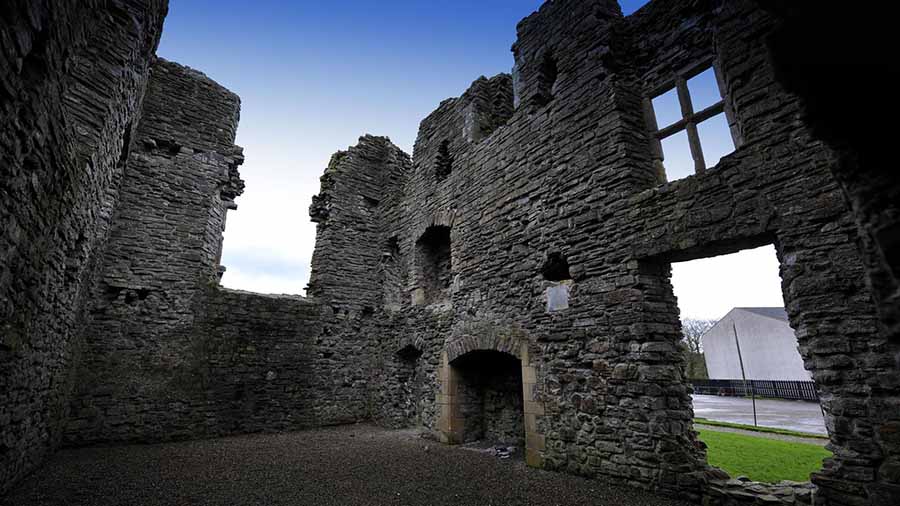
Castlecaulfield Castle, located in the village of Castlecaulfield, County Tyrone, is a large ruined mansion built by Toby Caulfield between 1611 and 1619 during the Plantation of Ulster. Situated in a serene, rural setting, the castle is a State Care Historic Monument managed by the Department for Communities, offering a glimpse into the region’s complex history.
The castle reflects the Plantation of Ulster’s impact, replacing Gaelic O’Donnelly control with English settlement. Its history ties to broader narratives of Irish rebellion and cultural shifts. The village’s accolades, including Ulster in Bloom (2015–2017) and Britain in Bloom (2016, 2018) awards, highlight community pride, with the Castlecaulfield Horticultural Society’s annual August show adding local flavour.
Historical and Architectural Highlights:
- Ruins and Structure: The castle, sometimes called Ballydonnelly Castle, was constructed on the site of an earlier O’Donnelly fort, a stronghold of the O’Donnelly sept, marshals to the O’Neill clan. The substantial ruins include a three-storey mansion with attics, large mullioned windows, and tall chimney stacks, originally U-shaped but now L-shaped due to the missing northwest wing. The gatehouse, the oldest surviving feature, showcases Tudor-style doorways, murder-holes, and gun-loops, with the Caulfield arms displayed above the entrance. A joist dated to around 1282 via dendrochronology suggests parts of the earlier fort will be incorporated, adding historical depth.
- Historical Context: Built by Toby Caulfield, later Lord Charlemont, on land granted during the Plantation of Ulster, the castle was burned during the Irish Rebellion of 1641 by Patrick Donnelly but repaired and reoccupied by the Caulfields until the 1660s. Notable historical figures, including Saint Oliver Plunkett (who held a service in 1670) and John Wesley (who preached in the ruins in 1767), add cultural significance. A plaque commemorates poet Charles Wolfe (1791–1823), author of The Burial of John Moore, who served as curate in nearby Donaghmore.
- Setting: The castle is set in a non-defensive location, emphasizing its role as a manor house rather than a fortress. Its limestone construction and probable slated roof reflect English architectural influences, contrasting with the Gaelic O’Donnelly heritage. The surrounding village, with its quiet main street, park, and two churches, adds to the tranquil atmosphere.
- Exploration: As a free, open-access site, visitors can explore the ruins at their leisure during daylight hours. The castle is adjacent to a village park, making it easily accessible for a short visit (30–60 minutes). The gatehouse and remaining walls are the main draw, offering opportunities for photography, particularly for events like weddings. The ruins are described as a recommended visit for their historical charm, though some visitors find the site understated due to its lack of formal facilities.
- Atmosphere: The castle offers a peaceful, low-key experience, ideal for history enthusiasts, photographers, or those seeking a quiet stop in County Tyrone. Reviews highlight the village’s charm, with one main street featuring a pub, shop, post office, and Saint Michael’s & All Saints Church, where a Blue Plaque honors Charles Wolfe. The lack of crowds makes it a “blink and you miss it” attraction, recommended for a brief, reflective visit.
- Nearby Attractions: Visitors can combine their trip with nearby sites, such as the Donaghmore High Cross and Saint Patrick’s Chapel (3 miles away), Hill of The O’Neill & Ranfurly House, or Dungannon Park. The castle’s proximity to these attractions makes it a convenient stop on a broader historical tour of Mid Ulster.
Amenities and Accessibility:
- Facilities: The castle has no on-site visitor center, café, or toilets, as it is an open ruin. Visitors can find amenities in Castlecaulfield village (pub, shop) or nearby Dungannon. The adjacent park offers a place to relax or picnic.
- The site is accessible on foot from the village, with free parking nearby. The terrain around the ruins is uneven, with grass and stone, so sturdy footwear is recommended. No specific accessibility features (e.g., ramps) are noted, and the site may pose challenges for those with mobility issues due to its ruinous state.
- Signage: The castle is signposted from Castlecaulfield village along the A45 Railway Road toward Aughnacloy, making it easy to locate.
What’s New:
- The society, which won the Queen’s Award for Voluntary Service in 2017, hosts an annual show in August, encouraging entries of horticultural and handicraft items. In August 2025, expect this event to continue, with increased promotion to draw visitors to the village and castle. Fundraising activities throughout the year may include castle-related walking tours or historical talks, augmenting the site’s visibility.
- Potential Maintenance Improvements: As a State Care Historic Monument, the Department for Communities maintains the castle.
- Practical Information Castle Grove, Castlecaulfield, County Tyrone, BT70 1AB, (3 miles west of Dungannon, off A45 Railway Road, signposted from the village).
- Cost: Free entry, as the site is an open ruin.
- Hours: Accessible daily during daylight hours; no formal opening times.
- Contact: For inquiries, contact Ranfurly House Arts & Visitor Centre at +4428 8772 8600 or check www.visitmidulster.com or www.communities-ni.gov.uk.
- Tips: Wear sturdy shoes for uneven terrain and bring a camera for the photogenic ruins. Visit in spring or summer for better weather and to coincide with the August Horticultural Show. Combine with Donaghmore’s High Cross and Saint Patrick’s Chapel (3 miles away) or Dungannon’s Hill of The O’Neill for a half-day trip. Parking is limited; use village spaces and avoid blocking roads.
- Weather: County Tyrone’s weather can be rainy; pack rain gear for outdoor exploration. Spring–summer (March–August) is ideal for visiting.
Castlecaulfield Castle offers a quiet, atmospheric experience, with its evocative ruins showcasing Plantation-era history and ties to the O’Donnelly and Caulfield families. Visitors can explore the gatehouse, mullioned windows, and surrounding parkland, ideal for a short stop or photography., expect continued community events like the Horticultural Show, though the site remains a low-key attraction. Its proximity to Dungannon and Donaghmore makes it a worthwhile addition to a County Tyrone itinerary. For the latest updates, visit www.visitmidulster.com or www.communities-ni.gov.uk.



